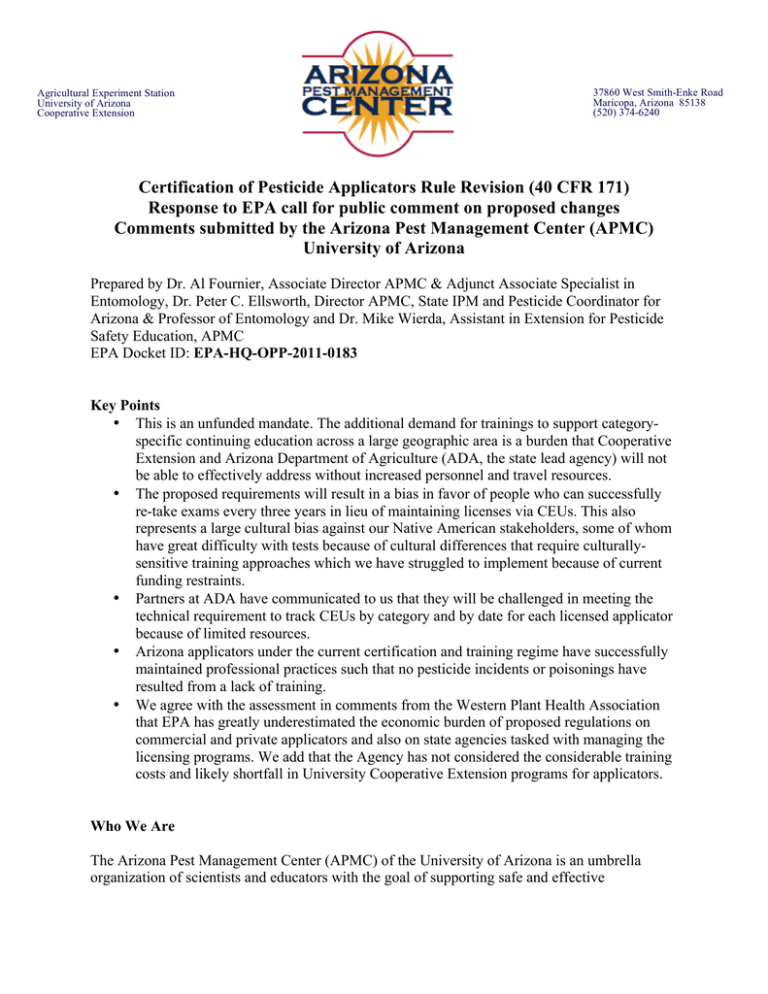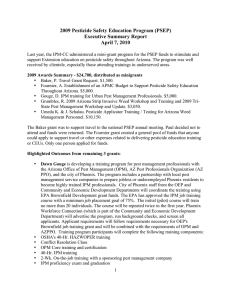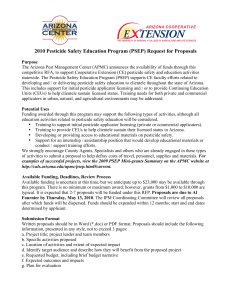Document 10669075
advertisement

Agricultural Experiment Station University of Arizona Cooperative Extension 37860 West Smith-Enke Road Maricopa, Arizona 85138 (520) 374-6240 Certification of Pesticide Applicators Rule Revision (40 CFR 171) Response to EPA call for public comment on proposed changes Comments submitted by the Arizona Pest Management Center (APMC) University of Arizona Prepared by Dr. Al Fournier, Associate Director APMC & Adjunct Associate Specialist in Entomology, Dr. Peter C. Ellsworth, Director APMC, State IPM and Pesticide Coordinator for Arizona & Professor of Entomology and Dr. Mike Wierda, Assistant in Extension for Pesticide Safety Education, APMC EPA Docket ID: EPA-HQ-OPP-2011-0183 Key Points • This is an unfunded mandate. The additional demand for trainings to support categoryspecific continuing education across a large geographic area is a burden that Cooperative Extension and Arizona Department of Agriculture (ADA, the state lead agency) will not be able to effectively address without increased personnel and travel resources. • The proposed requirements will result in a bias in favor of people who can successfully re-take exams every three years in lieu of maintaining licenses via CEUs. This also represents a large cultural bias against our Native American stakeholders, some of whom have great difficulty with tests because of cultural differences that require culturallysensitive training approaches which we have struggled to implement because of current funding restraints. • Partners at ADA have communicated to us that they will be challenged in meeting the technical requirement to track CEUs by category and by date for each licensed applicator because of limited resources. • Arizona applicators under the current certification and training regime have successfully maintained professional practices such that no pesticide incidents or poisonings have resulted from a lack of training. • We agree with the assessment in comments from the Western Plant Health Association that EPA has greatly underestimated the economic burden of proposed regulations on commercial and private applicators and also on state agencies tasked with managing the licensing programs. We add that the Agency has not considered the considerable training costs and likely shortfall in University Cooperative Extension programs for applicators. Who We Are The Arizona Pest Management Center (APMC) of the University of Arizona is an umbrella organization of scientists and educators with the goal of supporting safe and effective 2 implementation of integrated pest management (IPM) in agricultural, natural, and community settings in Arizona. The APMC plays an important role in ongoing education and providing of CEUs to help the 1,323 certified commercial and private applicators in agriculture and urban pest management to maintain their licenses and support their personal and environmental safety by keeping professionals well trained and up-to-date on practices and technologies. We work in tandem with the state lead agency, the Arizona Department of Agriculture (ADA), to support training and education that ensures the professionalism and safety of the industry. In collaboration with ADA, we have reviewed EPA’s proposed changes to certification of pesticide applicators under revision of 40 CFR 171. We have identified several specific ways in which the proposed changes would impact our ability to ensure public and environmental safety through education and licensing practices. ADA is expected to submit their own response dealing with impacts on their certification and licensing program. Our response deals mainly with impacts related to continuing education of certified applicators, although often these issues are intertwined. Background Arizona is a large and diverse state geographically, culturally, and in terms of pesticide applicator certification and training needs. Arizona is the sixth largest state in the U.S. Our 1,323 certified commercial and private applicators are spread over 113,998 square miles, with relatively small numbers of certified applicators residing in remote areas, including Native American lands, where overnight travel is required to conduct training. Arizona has only 15 counties, and even fewer County Agents with specific responsibilities for training these target audiences. Training needs range from urban and structural pest management in metropolitan areas to noxious and invasive weed control on remote rangelands, and trainings that support highly productive agriculture valued at over $3.7 billion according to the 2012 Census of Agriculture (1). Over 20 Native American Reservations make up about one-fourth of Arizona’s land area, and people from 22 federally recognized tribes reside here, many of them active in either small scale or commercial agriculture as well as maintenance of rights of way, park lands, and natural areas. Currently, only two people in AZ are specifically tasked with providing the majority of training and support for initial and applicator certification and trainings that provide CEUs for applicators. Dr. Mike Wierda is in a relatively new, soft-funded position with UA Cooperative Extension at the Arizona Pest Management Center and about two-thirds of his full-time position relates to providing training and resources to support Pesticide Safety Education. Ms. Jennifer Weber with Arizona Department of Agriculture (ADA, our state lead agency) is responsible for planning and implementing initial training and certification and CEU trainings for applicators, along with Train the Trainer events, Worker Protection Safety training, and other responsibilities. While many other individuals in Cooperative Extension contribute to trainings that provide CEUs in their areas of expertise, program coordination and trainings primarily targeting applicators are the responsibility of these two people. Under current regulations, we are struggling to address all training needs, and in particular those needs for underserved audiences in remote areas. This is due mainly to over-stressed budgets, lack of travel dollars, and the large geographic region to be covered. 3 Furthermore, there are cultural challenges to overcome. Years of experience have shown that lower exam pass rates are achieved with Native American audiences when “traditional” classroom trainings are used. Some efforts have been made to develop more culturally sensitive approaches to support these audiences, however, lack of appropriate funding and personnel has been an impediment to implementing a successful alternate approach on a consistent basis. Comments New requirements for category training Under National Certification Period and Standards for Recertification, Recertification Requirements Unit XIV.B., CEU requirements for each category of certification will have some problematic impacts in Arizona. (6 Core plus 6 Category CEUs for Commercial Applicators and 6 Core plus 3 category CEUs for Private Applicators every 3 years, with at least half earned in the last 18 months before expiration.) Currently, ADA approves CEUs provided through UA Cooperative Extension education programs as generally supporting commercial or private applicator training needs, not on a Core versus Category-specific basis. This works well in part because some of the categories do not have a large number of people certified. The proposed changes would require ADA to approve and track CEUs on a Core versus Category-specific basis and would therefore require education programs targeted at specific categories, several of which have relatively few license holders scattered geographically across our large state. Providing frequent enough trainings in all geographic areas to address category-specific CEU requirements will not be cost effective for Cooperative Extension and, frankly, is not a realistic expectation given the constraints described above, without additional funding support. For educators providing trainings for applicators, there will be an additional workload (an unfunded mandate) to produce study content and provide trainings to support category-specific requirements. As a result, programs that are developed may suffer in terms of quality and ability to address the diverse needs of specific stakeholders in the various categories. The very likely outcome is that UA Cooperative Extension programs will fail to keep pace with the number of category trainings that will be needed to support continuing education, especially in more remote areas of the state. On the other side of the equation, applicators will struggle to identify adequate training opportunities to maintain licenses in certain categories, and costs associated with these programs, when available, may be prohibitive. This is expected to lead to many applicators either dropping categories from their licenses or opting to re-test every 3 years rather than attending any relevant education programs. Our concern as educators is that in practical implementation this will lead to a less-informed, less up-to-date workforce, which is not in the best interest of the public or of EPA. Furthermore, creating a culture of “re-testing” versus maintaining licenses through CEUs will result in a large cultural bias against our large population of Native American stakeholders. As stated above (see Background), this population has had lower than average pass rates on certification exams and would benefit from culturally-sensitive 4 training approaches that we will be less likely to develop as educators become spread even more thin in trying to meet the expanded requirements for training. Soil fumigation category The proposed changes would establish Commercial and Private Applicator Categories for Soil Fumigation. A few years ago, the APMC in collaboration with ADA and industry partners organized training events to inform applicator communities in Arizona about changes to regulations affecting soil fumigation. With funding from a small EPA grant, we identified an extremely small target audience for these trainings, in a few geographic areas and were able to deliver trainings and post resources and information online to support safe and effective practices. Industry needs for training have been met without the implementation of a specific licensing category. For this handful of applicators, it will be burdensome for ADA and APMC to implement trainings and exams and track CEUs specific to this category. Our record of safety does not support the need for additional regulations in this area Arizona agricultural applicators under the current certification and training regime have successfully maintained professional practices such that no pesticide incidents or poisonings have resulted from a lack of training. Arizona has a very good safety record with respect to pesticide applications in these environments. There have been no pesticide related incidents or poisonings in our state due to uninformed or under-trained applicators. EPA’s economic analysis underestimates the cost of the proposed changes We agree with the assessment in comments from the Western Plant Health Association (http://www.regulations.gov/#!documentDetail;D=EPA-HQ-OPP-2011-0183-0555) that EPA has greatly underestimated the economic burden of proposed regulations on commercial and private applicators and also on state agencies tasked with managing the licensing programs. Applicators will have to invest much more than the EPA estimate of $40 (in lost work time to alone) to attend additional required Core and Category training sessions to maintain their licenses. It is also unreasonable to require that 50% of the CEUs required be obtained in the last 18 months prior to license expiration. For reasons explained above, applicators may need to attend category trainings when they are available and hopefully close to where they work and live. Additional costs to state lead agencies tasked with providing training, testing and tracking of CEUs have also been underestimated by EPA. Additional personnel costs, hardware, software and training costs have not fully been accounted for in the EPA’s economic analyses. References (1) Manheimer, S. 2014. Arizona Agriculture by the Numbers in 2014. Arizona Farm Bureau article, 5/14/14. http://www.azfb.org/articles/118298/arizona-agriculture-by-the-numbersin-2014





